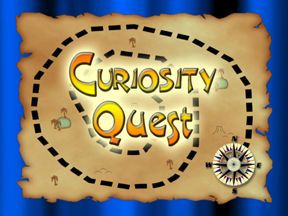What are you curious about?
That’s the question asked in each episode of the family-friendly, fun program Curiosity Quest. My family received two DVDs for review: DVD Combo Pack – Produce and DVD Combo Pack – Swimmers of the Sea. Each of these DVDs has three episodes on it and retails for $24.95.
Before this came up for review, I’d never heard of the program, but it’s on PBS stations around the country. (We don’t have a TV.) My kids, like most others, are naturally curious about the things all around them, though, so I knew this would be a good fit for our family. (In case you’re wondering, we watched them on the computer.)
Before I dive into the individual episodes, let me explain a bit what Curiosity Quest. It’s an educational television show hosted by Joel Greene wherein he takes viewers’ emails (hence the “What are you curious about?”) and tries to find out all the information he can on a given subject. He does this by going on site to various locations around the country (possibly around the world, but I’m not sure; the episodes we watched were just in America) and talking to experts in the field. But it’s not a boring interview. He actually becomes an employee for the day (kind of) at the different places. Joel’s learning right along with the viewers! It’s very cool and fun.
I let the boys pick which disc they wanted to watch first, and not surprisingly they chose Swimmers of the Sea. We just watched one episode at a time – there’s a reason we don’t have a TV, and educational or not, I don’t want them watching loads of shows all the time.
First up was Penguins. We’d done a unit study on penguins last year (based on the novel Mr. Popper’s Penguins), so there wasn’t a whole lot that the boys learned from this episode, but they did learn a little bit – and loved watching it despite the fact that they already knew a lot of the information. For example, did you know that penguins have roughly 1,000 feathers per square inch of their bodies? This makes them incredibly soft, and more importantly, helps keep them warm in the cold Antarctic waters. Also, even though we’ve seen penguins in real life at the zoo and the aquarium, it’s been a long time since we’ve been either place, so when asked the question “What sound do penguins make?” they couldn’t come up with anything. They really liked hearing a real penguin, even if it was just over the speakers.
Next we watched the episode on Sea Turtles. This one was neat because it takes place in a sea turtle rehabilitation hospital in Florida. It was really cool to see and learn not just about sea turtles, but about the dangers they go through every day and how this veterinary clinic was taking in sick wild turtles and healing them so they could survive in the sea again.
Finally was salmon. My kids were especially interested in this one because salmon is one of their favorite fishes to eat! Joel visited a salmon hatchery in Alaska to learn all kinds of cool things. They taught us how they train their fish to come back to their specific hatchery to spawn (by keeping them in huge nets while they acclimate to the scent of the bay). It was really interesting to find out that salmon don’t spawn every year. Maybe this is “common knowledge,” but I didn’t know it. After this hatchery sets the fish free, the fish are wild for 3-7 years, depending on the variety of the salmon it is, and then comes back to spawn once they’re mature. Then they die. I had no idea salmon only got one chance to lay eggs.
The Produce combo DVD was just as fun as the Swimmers of the Sea one. It taught us all about Cranberries, Oranges, and Mushrooms.
Did you know cranberries don’t need the bog they’re famous for to grow? That’s a harvesting technique; because the berries are essentially hollow, farmers flood the fields to make the berries float, therefore making harvesting easier.
Despite all the technological advances of our time, there’s still no machine that can harvest oranges without damaging them, so every single orange is harvested by hand.
Mushrooms are harvested by hand, too, but in a kind of “factory” rather than an orchard.
Each episode also takes a moment, several times throughout, to ask kids a question about what they’re about to learn. That takes the show from strictly passive, like most TV, to a bit more engaging. It was during one of these moments that my boys realized they didn’t know what a penguin sounded like. I always paused the video during these and made the kids try to come up with some sort of answer to the question being asked.
My kids really enjoyed these episodes. They learned a lot of things about all six of the subjects that they didn’t already know, including but not limited to what I shared in this post. This show would make a fabulous addition to a unit study. And the six I’ve talked about are not nearly all of them! Animals and food aren’t even the only topics covered. Curiosity Quest has done episodes on everything from horseback riding to cheerleading, movie animatronics to bike building. There is quite literally something for everyone. Even though the “ideal age range” of the show is 7-14, I think it could easily appeal to kids both younger and older – after all, I’m 32, and I learned a lot from them too!
So again I ask: What are you curious about? Find yourself a Curiosity Quest episode and learn about it. And better yet, use that episode to springboard into further learning. You won’t regret it!
Blessings,
Wendy
P.S. You can connect with Curiosity Quest on Facebook, Twitter, and YouTube.





